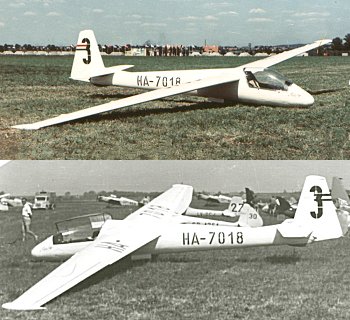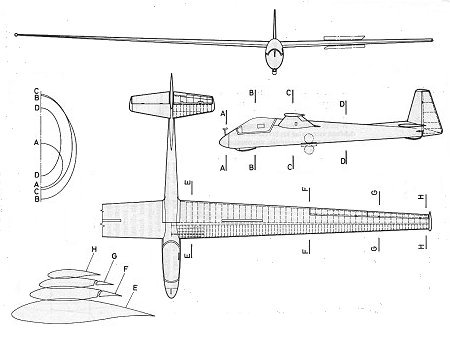HUNGARIAN
GLIDERS
1933-2000
| Type designation: |
A-08b |
| Name: |
Sirály-II |
| Designer: |
Ferenc ZSEBŐ and his team: Lajos ROTTER, János CSERKUTI, Jenő OROSZ, Béla SAMU, József TÓTH, Gábor JEREB, Géza GARAMI and János VÁGHEGYI |
| Class: |
High performance |
| General arrangement: |
Shoulder wing, bubble canopy, retractable wheel, traditional tail unit |
| Crew: |
1 |
| First flight: |
May, 1958 |
| Manufacturer: |
Sportárutermelő V. (formerly Aero-Ever Ltd), Esztergom |
| Number of built: |
2 |

Short history:
A new version of the A-08 Sirály had been developed for the World Gliding Championships held in Leszno, Poland, in 1958. The new version's designation was A-08b Sirály-II. For the development work Lajos Rotter joined the original development team of the A-08.
The shoulder wing glider's general arrangement was similar to the A-08 Sirály, however instead of trailing edge airbrake and brake parachute a Göppingen type airbrake was fitted, and the contour of the fuselage was slightly modified.
Two A-08b Sirály-II were built in the Sportárutermelő V. (formerly Aero-Ever Ltd.), Esztergom. First flights of the gliders were at May, 1958, just before the beginning of the World Championships. The story of the pervious version was repeated: no good results were achieved due to the lack of experience with the gliders.
In spite of the meagre results at the World Championships both versions had played an important role in the history of Hungarian gliding. Their performances equaled those of the best contemporary gliders of the world, and Hungarian glider pilots flying these gliders entered the era of modern "speed over a course" type competition flying.
The glider was certified for cloud flying, for spins an basic aerobatics.
The most remarkable results of the A-08b Sirály-II are the following:
1958: speed over a 100 km triangle course, 76,31 km/h, national record (László Legenyei); speed over a 300 km triangle course, 63,24 km/h, national record (László Legenyei); 453 km free distance (László Legenyei); 390 km free distance (Ernő Kisely);
1959: speed over a 300 km triangle course, 69,01 km/h, national record (Ernő Mandl);
1960: out-and return distance, 352 km, national record (Anna Gyimesi); height gain, 3140 m, national record (Anna Gyimesi);
1961: speed over a 300 km triangle course, 71,1 km/h, national record (Nándor Opitz); out and return distance, 400 km, national record (Nándor Opitz); speed over a 200 km straight course, 113,25 km/h (Gábor Kotrás);
1962: speed over a 200 km triangle course, 74,31 km/h, national record (Nándor Opitz); speed over a 500 km triangle course, 62,7 km/h, national record (Pál Szereday); speed over a 300 km triangle course, 78,3 km/h, national record (György Petróczy); 440 km distance (György Ujvári); height gain, 4200 m (György Ujvári).
Structure: Wooden wing with light alloy main spar, wooden fuselage and tail unit
Wing:
The wingtips of the tapered planform one-spar wing had "salmon" shaped fairings. The Frise-type ailerons were split spanwise. The main spar was made of light metal. The booms were made of a comb-like section, the web was made of duraluminium sheet. The web was riveted to the booms. The ribs were made of wood and their upper as well as lower flanks were not broken at the main spar. The ribs were attached to the web of the main spar by brackets. The wing was covered by plywood. The plywood was glued to wooden laths attached to the metal booms of the main spar. The wings' main attachment fittings connected to a vertically positioned pin, which was built into a strong double frame in the fuselage and was encased in rubber.
Fuselage:
The wooden, plywood covered semi-monocoque fuselage had elliptic cross section, and had a conical form behind the greatest cross section. In the roomy cockpit the pilot seated in semi-declined position. The fore part of one-piece bubble canopy had one-way curvature to prevent distortion of view. The nose was more slanted, then that of the A-08. The landing gear consisted of a small nose and a small tail skid, as well as a retractable, sprung main wheel located behind the c.g. of the empty glider.
Tail unit:
The surfaces of the traditionally arranged tail unit were tapered and were relatively small due to the long fuselage. Both control surfaces were mass-balanced.
.jpg)

| Dimensions: |
| Wing: |
| Span, m: |
17,6 |
| Area, m2: |
16,2 |
| Aspect ratio: |
19,2 |
| Chord (root), m: |
1,32 |
| Chord (tip), m: |
0,48 |
| Airfoil (root), m: |
NACA 64(3)-618 |
| Airfoil (mid-span), m: |
NACA 64(3)-618 |
| Airfoil (tip), m: |
NACA 64(3)-618 |
| Dihedral, degree: |
2,5 |
| Sweep, degree: |
0 |
| Washout: |
-1,5 degree geometric |
| Aileron: |
| Span, m: |
4,0 (split spanwise) |
| Mean chord, m: |
0,175 |
| Total area, m2: |
1,4 |
| Balancing: |
Mass |
| Flap: |
| Type: |
None |
| Airbrakes: |
| Type: |
Göppingen |
| Position (upside/downside): |
u/d |
| Total area, m2: |
0,76 |
| Position, % of chord: |
0,515 |
| Horizontal stabilizer: |
| Span, m: |
2,9 |
| Area, m2: |
1,75 |
| Elevator: |
| Span, m: |
2,9 |
| Area, m2: |
0,665 |
| Airfoil: |
NACA 64-009 |
| Balancing: |
Mass |
| Trim: |
Yes |
| Vertical stabilizer and rudder: |
| Total area, m2: |
1,73 |
| Rudder area, m2: |
0,75 |
| Balancing: |
Mass |
| Fuselage: |
| Length, m: |
7,68 |
| Width, m: |
0,62 |
| Height: |
0,93 |
| Cross section, m2: |
0,52 |
| Landing gear: |
| Type: |
Retractable, sprung |
| Wheel diameter, m: |
0,36 |
| Masses: |
| Wing, kg: |
180 |
| Fuselage, kg: |
105 |
| Tail unit, kg: |
10 |
| Empty glider, kg: |
310 |
| Gross, kg: |
410 |
| Ballast, kg: |
None |
| Wing loading, kg/m2: |
25,3 |
| Speeds: |
| VNE, km/h: |
250 |
| Max. speed with open airbrakes, km/h: |
250 |
| Max. aerotow speed, km/h: |
150 |
| Max. winch speed, km/h: |
120 |
| Max. speed in rough air, km/h: |
150 |
| Stall speed, km/h: |
62 |
| Performance: |
| Min. sink, m/s (at gliding speed, km/h): |
0,6/70 |
| Best L/D (at gliding speed, km/h): |
34,2/80 |
| Start methods: |
Winch, Aerotow |

Origin of data and 3-view drawing:
Jereb Gábor: Magyar vitorlázó repülőgépek, Műszaki Könyvkiadó, 1988, Budapest
(Gábor JEREB: Hungarian Gliders, Technical Publishing House, 1988, Budapest)
Gábor FEKECS E-mail: fekecs.gabor@t-online.hu

.jpg)
